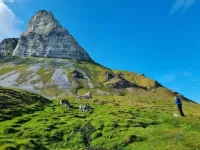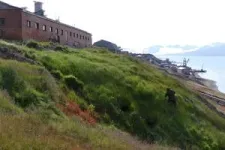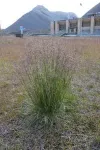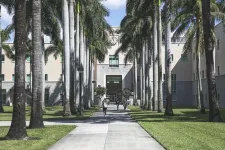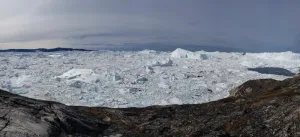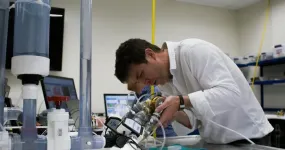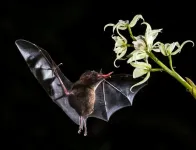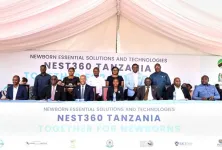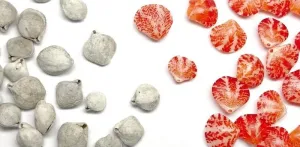(Press-News.org) New, non-native plant species are constantly being discovered in Svalbard, and researchers are working to ascertain what threat these species pose to the native plants.
So far, the Arctic has managed to avoid one of the most serious threats to biodiversity on Earth. This is also true for Svalbard, but things could change very quickly, and researchers want to find out how to counteract this threat.
“Increased human activity heightens the risk of new plant species being introduced. And climate change increases the risk of invasive species establishing themselves,” says Kristine Bakke Westergaard.
She is an associate professor at the Department of Natural History, which is part of the University Museum at the Norwegian University of Science and Technology (NTNU).
No checks on arrival to Svalbard
New species can outcompete the plants already present in Svalbard. Non-native species are spreading across large parts of the globe and can disrupt the established balance between species in a certain area.
Human activity is to blame for the spread of new, non-native species to new areas. Svalbard is particularly at risk because of its popularity as a destination for cruises and other tourist activities. However, upon arrival in Svalbard, visitors are not checked to see if they are carrying any biological stowaways. For example, no one checks whether air passengers or cruise tourists have contaminated shoes, or whether imported soil contains seeds.
On the other side of the globe in Antarctica, there are much stricter requirements and checks to prevent these types of introductions. The lack of biosecurity routines in Svalbard worries researchers.
The warmer climate supports new species
Currently, only the hardiest species are able to survive in Svalbard. However, the archipelago has become much warmer in recent years, enabling more species to establish themselves.
“We have developed models to map 27 non-native plant species and their potential to find new habitats and suitable climates in Svalbard,” says James Speed, a professor at NTNU’s Department of Natural History.
Currently, all of these species are only found in the inhabited parts of Svalbard. The researchers mapped out which areas of Svalbard have the optimal combination of temperature and precipitation for these species, both now and in the future.
“In relation to the current climate, we have identified three species that have particularly high potential to find new habitats in Svalbard. If they manage to spread to these areas, they could pose a threat,” says James Speed.
The three species that could spread the most are:
Tufted hairgrass (Deschampsia cespitosa)
A species of meadow buttercup (Ranunculus subborealis subsp. villosus)
Alpine saw-wort (Saussurea alpina)
All areas of Svalbard could be at risk
The models show that almost all areas of Svalbard will develop a suitable climate for many of these non-native plants. The uninhabited islands of Edgeøya and Barentsøya to the east, as well as the island of Bjørnøya with its manned meteorological station to the south, are most at risk. However, things can change quickly.
“In the future, as the climate warms, most of the non-native species we investigated have the potential to spread throughout Svalbard. Many of the species that do not belong in Svalbard may be able to spread over a much wider area than they are currently able to do,” says Westergaard.
Factors other than temperature and climate also play a role in preventing new species from spreading. Among other things, limited access to nutrient-rich soil has kept their prevalence to a minimum. This, however, also seems to be changing.
Urgent intervention required
The researchers are of the opinion that the environmental authorities must act quickly if they are to limit and prevent these invasive non-native species from spreading beyond the areas where they already exist.
In addition, the researchers say society must prioritize preventing new non-native species from spreading to Svalbard before the threat to the Arctic ecosystem becomes too great and unmanageable.
This study is part of the Biodiversa project ASICS (ASsessing and mitigating the effects of climate change and biological Invasions on the spatial redistribution of biodiversity in Cold environmentS). The Norwegian team is funded by the Research Council of Norway. Other contributors include the South African National Research Foundation and the Millennium BASE Institute.
References: Speed JDM, Pertierra LR, Westergaard KB (2024) The potential area of occupancy of non-native plants across a warming high-Arctic archipelago: Implications for strategic biosecurity management. NeoBiota 93: 157-175. https://doi.org/10.3897/neobiota.93.114854
END
Svalbard: Non-native species are threatening vulnerable plant life
Authorities need to act more aggressively to prevent the accidental introduction of non-native plant species to arctic ecosystems
2024-07-25
ELSE PRESS RELEASES FROM THIS DATE:
Cultivating better leadership: KLU and partners create Texl.org - a free, scientific evidence-based 360-degree assessment tool
2024-07-25
Available to anyone, anywhere, at anytime, Texl.org allows individuals and organizations to create scientifically valid surveys in less than five minutes. In drag-and-drop fashion, survey creators can choose from an ever-growing list of 50 validated scales, measuring aspects ranging from team conflict to personal initiative and transformational leadership.
“The point of science is to develop knowledge that ultimately is to the benefit of society. Unfortunately, we are not always great in translating our knowledge so that it is usable for practitioners out there. With Texl we’re changing that,” explains Professor Niels Van Quaquebeke, ...
FAU researcher receives grant to personalize radiation therapy for cancer
2024-07-25
While chemotherapy has advanced in personalization, personalized radiation therapy for cancer remains underdeveloped. Current cancer treatment methods – including radiation therapy – are intricate, lack personalization, and rely heavily on the expertise of medical teams. Medical image analysis and machine learning hold great promise for enhancing personalized oncology. However, challenges persist such as limited high-quality data and data complexity.
Wazir Muhammad, Ph.D., principal investigator and ...
MD Anderson and Summit Therapeutics announce strategic collaboration to accelerate development of ivonescimab
2024-07-25
HOUSTON and MIAMI ― The University of Texas MD Anderson Cancer Center and Summit Therapeutics, Inc. today announced a strategic five-year collaboration agreement for the purpose of accelerating the development of ivonescimab.
Leveraging MD Anderson’s clinical infrastructure and research expertise together with Summit’s innovative, investigational, potential first-in-class PD-1/VEGF bispecific antibody, the collaboration is designed to quickly discover additional opportunities for ivonescimab, including several tumors outside of its current development plan. MD Anderson will lead multiple clinical trials in several tumor types to evaluate the safety and potential clinical ...
Warming has more impact than cooling on Greenland's "firn"
2024-07-25
Scientists have known from ice core research that it's easier to melt an ice sheet than to freeze it up again. Now, they know at least part of the reason why, and it has to do with ice's "sponginess," according to a new study published July 24 in The Cryosphere.
The study uses a physics-based numerical model to assess the impacts of warming and cooling on firn, the porous layer between snow and glacial ice, over the entire Greenland Ice Sheet. Megan Thompson-Munson, a CIRES and ATOC PhD student, led the study alongside ...
The Texas Heart Institute implants BiVACOR® Total Artificial Heart
2024-07-25
Houston, Texas, July 25, 2024 – The Texas Heart Institute (THI) and BiVACOR®, a clinical-stage medical device company, announced today the successful first-in-human implantation of the BiVACOR Total Artificial Heart (TAH) as part of the U.S. Food and Drug Administration (FDA) Early Feasibility Study (EFS) on July 9, 2024. BiVACOR’s TAH is a titanium-constructed biventricular rotary blood pump with a single moving part that utilizes a magnetically levitated rotor that pumps the blood and replaces both ventricles of a failing heart.
The first-in-human clinical ...
University of Washington researchers take flight with new insights on bat evolution
2024-07-25
University of Washington Researchers Take Flight with New Insights on Bat Evolution
Video Interview with Authors - https://youtu.be/6rogrh2_HN0
In new research published in PeerJ Life & Environment, researchers from the University of Washington, University of Texas at Austin and Oregon Institute of Technology, led by undergraduate student Abby Burtner, have advanced our understanding of the evolutionary origins of flight in bats. The study, titled "Gliding toward an Understanding of the Origin of Flight in Bats," employs phylogenetic comparative methods to explore the evolutionary transition from gliding to powered flight in these unique mammals.
Bats ...
Tanzanian officials praise NEST360 contribution to newborn care
2024-07-25
HOUSTON – (June 25, 2024) – Rice University President Reginald DesRoches joined Rice360 Institute for Global Health Technologies Co-Director Maria Oden and Rice360 supporters on a trip to Africa this summer marking significant milestones on the road to ending preventable newborn deaths in the sub-Saharan region. Rice360 is one of 22 organizations in the Newborn Essential Solutions and Technologies (NEST360) international alliance, and this trip signified Rice’s continued collaboration ...
4D Medicine raises £3.4 million for unique biomaterial platform
2024-07-25
4D Medicine, a spin-out from the Universities of Birmingham and Warwick has raised £3.4m ($4.4m) in a Series A investment.
The funding round was backed by Oshen Holdings, DSW Ventures, SFC Capital, Boundary Capital and private investors including several leading scientists and surgeons. It will enable the company to complete pre-clinical testing of its first product range and seek FDA clearance for entry into the US market.
4D is a UK-based company whose innovative biomaterial has potential to be used for a wide range of 3D printed implants and surgical devices. Its product 4Degra is a resorbable biomaterial that is being used to develop ...
Ancient marine animal had inventive past despite being represented by few species, new study finds
2024-07-25
The findings, published today in Nature Ecology & Evolution, sheds light on some core principles of the evolution of modern biodiversity.
In current oceans, molluscs such as clams, oysters, and snails are hugely diverse, with over 50,000 species, whereas brachiopods are rare by comparison with only 394 species known. But this was not always the case. The team have found that brachiopods were evolving new shell shapes and ecological behaviours following the end-Permian mass extinction which compromised their numbers.
“In the Palaeozoic, from 540 to 250 million years ago, brachiopods ruled the seabed,” ...
Quantum sensor for the atomic world developed through international scientific collaboration
2024-07-25
In a scientific breakthrough, an international research team from Germany's Forschungszentrum Jülich and Korea's IBS Center for Quantum Nanoscience (QNS) developed a quantum sensor capable of detecting minute magnetic fields at the atomic length scale. This pioneering work realizes a long-held dream of scientists: an MRI-like tool for quantum materials.
The research team utilized the expertise of bottom up single-molecule fabrication from the Jülich group while conducting experiments at QNS, utilizing the Korean team’s leading-edge ...
LAST 30 PRESS RELEASES:
UC San Diego Health Sciences Grant Writing Course helps launch successful research careers
Study: Many head and neck cancer trials end early. Why?
Tufts vice provost for research named Foreign Fellow of Indian National Science Academy
New model improves prediction of prostate cancer death risk
Two wrongs make a right: how two damaging variants can restore health
Overlooked decline in grazing livestock brings risks and opportunities
Using rare sugars to address alcoholism
Research alert: New vulnerability identified in aggressive breast cancer
Ruth Harris honored with SSA Distinguished Service Award
Treasure trove of data on aging publicly accessible
Trees4Adapt project to address risks from climate change and biodiversity loss through tree-based solutions
Nature Communications study from the Lundquist Institute identifies molecular mechanism underlying peripartum cardiomyopathy
Pennington Biomedical’s Dr. Gang Hu appointed to NIH Reproductive, Perinatal and Pediatric Health Review Group
World-first project shows great promise to treat low eye pressure
New technique puts rendered fabric in the best light
Brain cancer digital twin predicts treatment outcomes
Cat disease challenges what scientists thought about coronaviruses
Paulson Family Foundation makes an additional $19 million donation to Hebrew University to fund a new building for electrical engineering. Together with its previous gift brings the total donation to
Canada–Estonia partnership advances community-centered clean energy
Sandia’s economic impact sets record for 17th consecutive year
Researchers uncover how tumors become resistant to promising p53-targeted therapy
Aligning games and sets in determining tennis matches
UOC research team develops method to evaluate apps for treating depression
Extreme heat waves disrupt honey bee thermoregulation and threaten colony survival
New brain study explains how binge drinking contributes to long-lasting negative feelings
The Food and Drug Administration’s regulation of mifepristone
Prescribing patterns of potentially inappropriate central nervous system-active medications in older adults
One in four older Americans with dementia prescribed risky brain-altering drugs despite safety warnings
Social media use and well-being across adolescent development
Child poverty trends by race and ethnicity in the U.S. from 2022 to 2025
[Press-News.org] Svalbard: Non-native species are threatening vulnerable plant lifeAuthorities need to act more aggressively to prevent the accidental introduction of non-native plant species to arctic ecosystems
